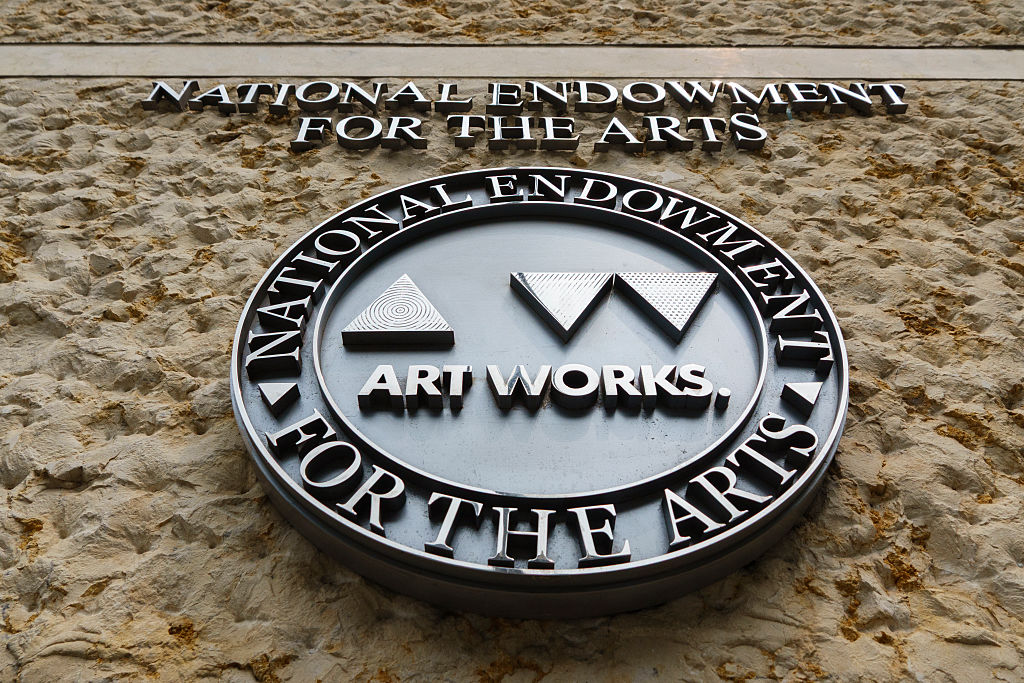Paint It Black
What is the point of state-sponsored mediocrity in the arts?

Thirty-some years ago, I quite enjoyed myself debating the abolition of the National Endowment for the Arts on campuses and in halls of state across the fruited plain. My forensic opposite numbers tended to be arts bureaucrats or recipients of federal largesse, and they assumed that I must be a philistine who’d gotten all bent out of shape due to the handful of high-profile NEA grants for pornographic or scatological pranks: the urine-soaked crucifix of Andres Serrano, the bullwhips of Robert Mapplethorpe, etc.
I may well be a philistine. Hey, summer’s here, and the time is right for my annual binge of ’70s drive-in movies; anyone up for a Jan-Michael Vincent film festival? But I refused to play the part I was assigned in those debates. My argument was not that subsidized artists are subversive but that they are tame, neutered, obedient.
I didn’t quote Jesse Helms but rather the long and raggedly noble roster of artists who have spurned or denounced government sponsorship: Beat impresario Lawrence Ferlinghetti, Pop Artist Larry Rivers, Jacques Barzun, Ernest Hemingway, Gore Vidal, John Updike—this line of what Robert Frost called “insubordinate Americans” stretches back to the New Deal’s Federal Art, Theatre, and Writers’ Projects, the earliest attempt to pen artists in the federal corral.
William Faulkner and Edward Hopper pointedly refused any connection with these projects, for, as Faulker declared, the writer “mustn’t accept gratuity from the state. He mustn’t let the state buy him.” (Faulkner’s brother John even wrote an anti-New Deal novel, Men Working.)
The dividing line was never one of ideology but rather temperament. In 1937, John Sloan, former art editor of the socialist magazine The Masses and cofounder of the Ashcan School of art, dismissed the proposed Bureau of Fine Arts: “I hate nearly everything [government] does, its support of privilege, the wars it gets us into. Why shouldn’t I hate it in my own line, my own calling? Having the government the advocate of the mediocre in art, the employer of art, would be a good thing. We would know where to locate the enemy.”
I fully realize how terribly quaint this all sounds today. Abjure power? Nah—the dead-eyed bores of the woke left and the rough boys of the nationalist right fetishize power, and when they achieve it they damn sure intend to use it.
Conscientious objectors who wish neither to wield nor submit to power are as impractical as unemployed poets, whiskey priests, and dandelions.
Like the Interstate Highway System, NASA, and metric conversion, the National Endowment for the Arts was a Cold War baby. Its most vigorous congressional advocate, Rep. Frank Thompson (D-NJ), a “liberal’s liberal,” as the New York Times called him, declared: “Making Washington the cultural center of the world would be one of the very best and most effective ways to answer the Russian lies and defeat their heavily financed effort to have Communism take over the world.”
A national arts agency would prove to the world that Americans are not “gum-chewing, insensitive, materialistic barbarians,” harrumphed Thompson, whose career went splat when in 1980 he was caught in the FBI’s Abscam sting. Convicted of bribery, he spent two years in the federal pokey, where gum-chewers were the least of his worries.
Saying what the heck, I served on an NEA panel one weekend in 2004, during the endowment’s golden age: Its chairman, Dana Gioia, was and is a major American poet.
Subscribe Today
Get daily emails in your inbox
I was impressed by the diligence of the NEA staff, though I’m afraid I committed a faux pas by casting the lone nay vote on our final package due to the gross regional imbalance of the grantees, more than half of which were located in California and New York. Same as it ever was: One year, New York City accounted for 45 percent of all Federal Art Project dolesters while not a single artist in Texas or either Dakota received a penny.
After that spasm of public-spiritedness—you may thank me for my service—I gave up writing or speaking about subsidized art. I had nothing more to say about the matter, and, given the enormity and enormousness of Uncle Sam’s death-dealing in the Middle East, it seemed kinda silly to whine about the relative pittance Washington sent to perfectly fine symphony orchestras and striving regional theaters and even borderline-personality-disordered performance artists. I just didn’t care anymore.
What’s next for the NEA? There are abolitionists within the Trump administration, God bless ‘em, though I’d not be shocked by a compromise that installed Lee Greenwood as national recording-artist-in-residence. Just leave the rest of us alone, and please 86 the next functionary who says that art streams from a government spigot.